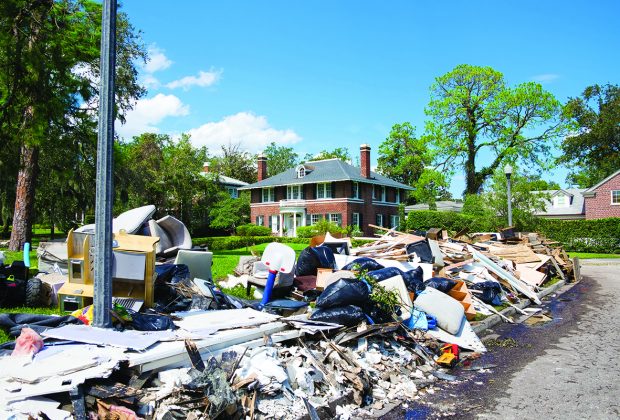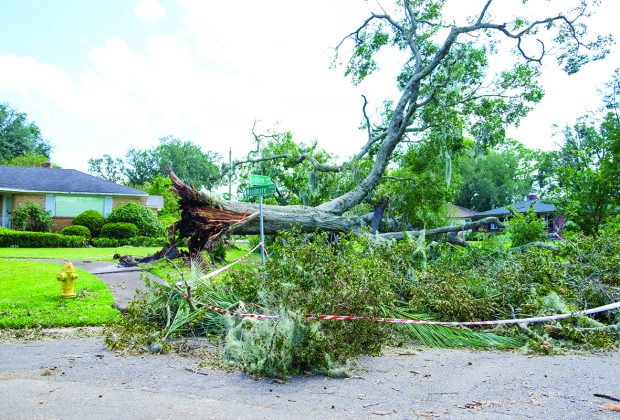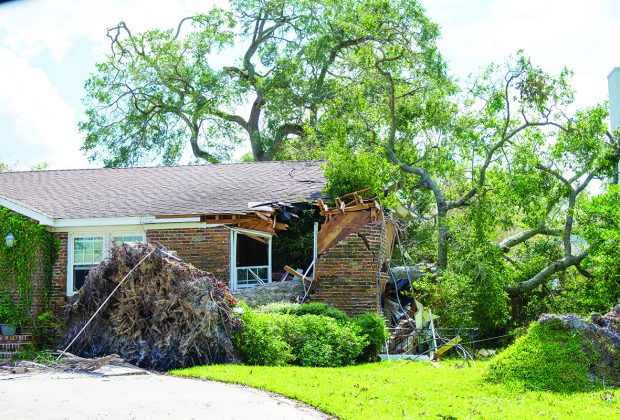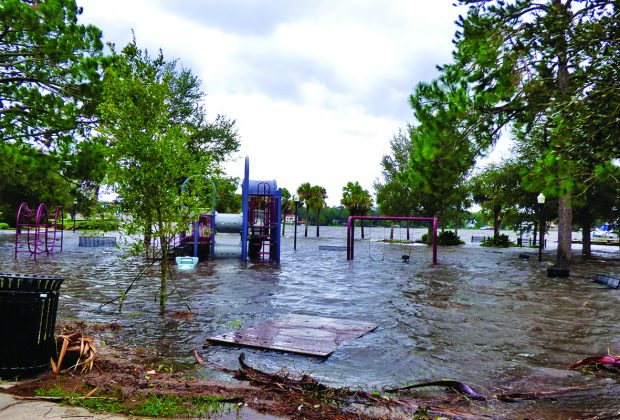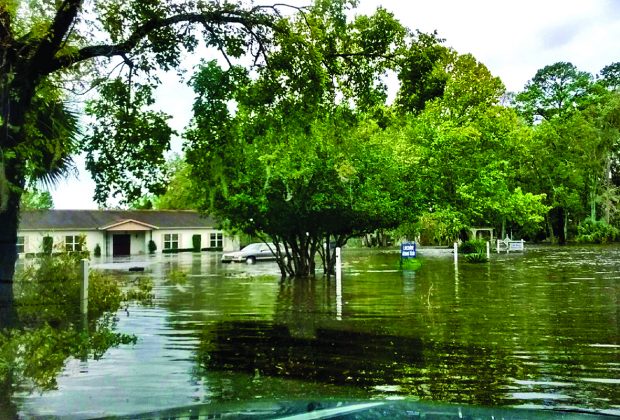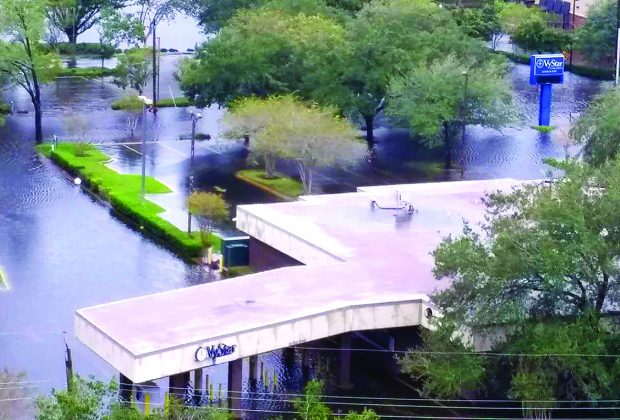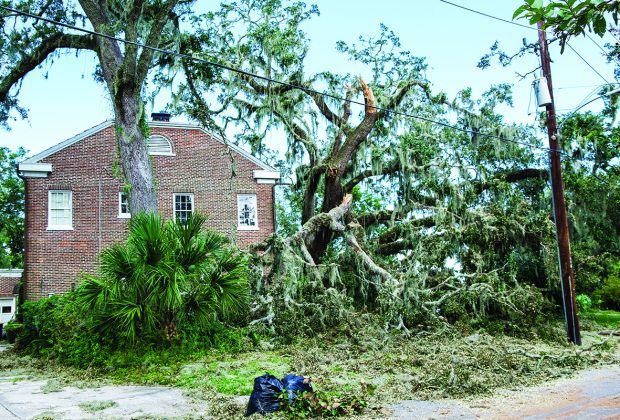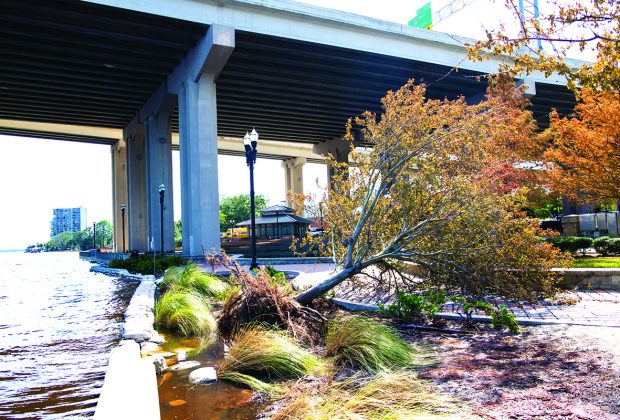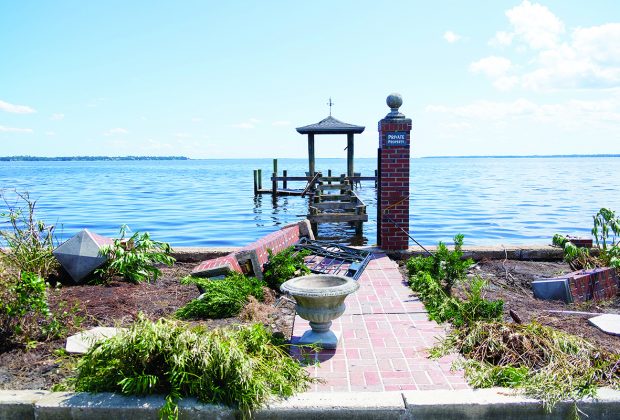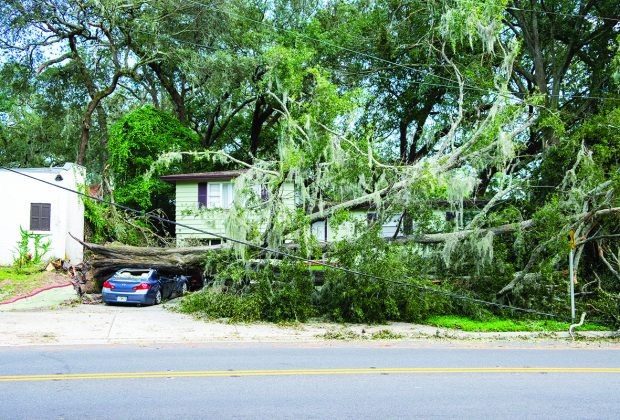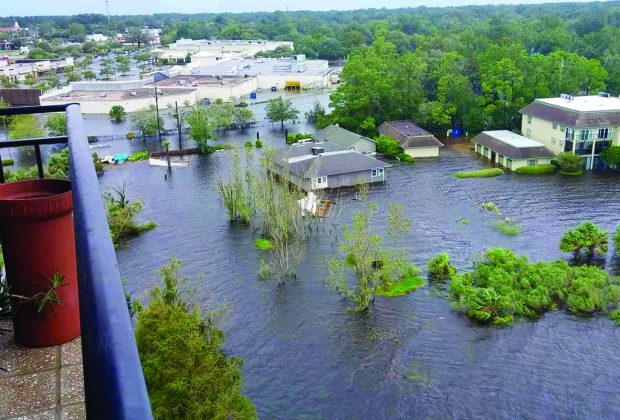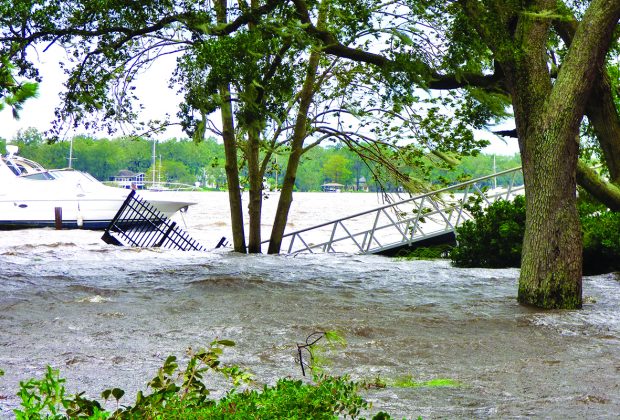Irma delivered a staggering blow, epic wind and flood waters shock residents
Posted on October 6, 2017 By Editor Articles, Neighborhood News, Top Stories
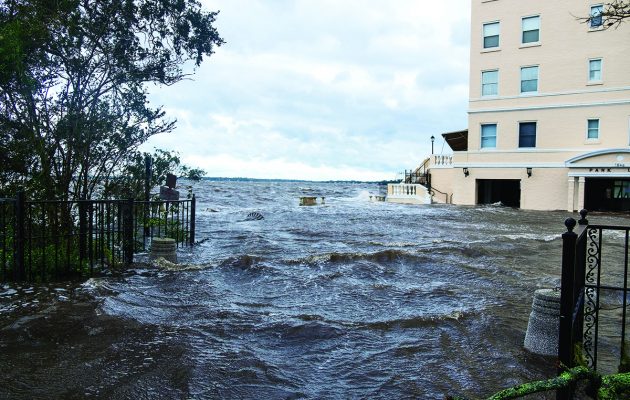
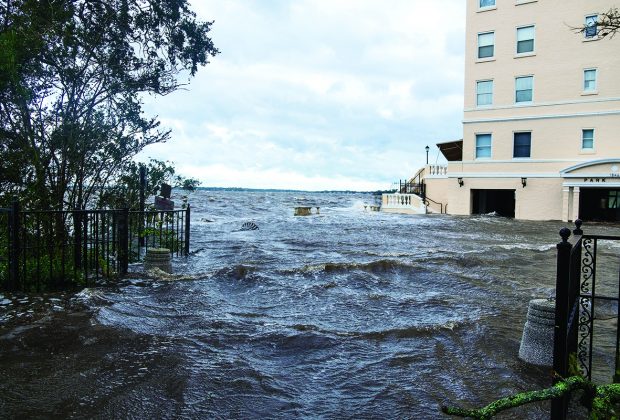 Margaret Street between Memorial Park and Park Lane Condominium looked like a tributary of the river
Margaret Street between Memorial Park and Park Lane Condominium looked like a tributary of the river“Still getting pounded hard with roaring winds barreling at us off the river. The pressure is intense. The St. Johns is in my lower yard like an angry ocean. Dock is gone next door. Lots of exterior damage. 3 a.m. was frighteningly intense. Barrel tiles hurling off the roof, light fixtures flying, branches falling. This isn’t like any tropical storm I’ve ever experienced…”
This was how Anne Burpee Rain, a realtor who lives on Apalachee Street in Ortega, described her 14-hour ordeal during Hurricane Irma on Facebook at 8:40 a.m. Sept. 11. By 1:20 p.m. she had posted a photo of an upset St. Johns River, which had encroached 20 feet into her yard. The dock, which had been torn from pilings in front of her neighbor’s house ended up in her yard, she said.
“It was by far the worst storm I’ve ever seen,” said Rain, who grew up in Ortega Forest. “I’ve been in this house 10 years. There was once another storm with 70 mph gusts, which was a little scary, but with Irma the winds were persistent. This was crazy scary. It was frightening,” she said.
Days before she hit, local weather forecasters had warned Jacksonville residents Hurricane Irma would be a monster storm hitting the Florida Keys at Category 4 or 5. First they predicted she would veer east, perhaps chewing up the Jacksonville beaches but sparing downtown from the roughest winds. However, Irma had her own ideas, drifting further west when the time came, sweeping up the entire width of the Florida peninsula and forcing residents from the Florida Keys to Jacksonville to scramble out of her way.
Although Jacksonville did not suffer a direct hit from the ocean such as it had in Hurricane Dora, the city did endure the harshest winds from the northeast quadrant of the storm, and flooding of the St. Johns River was as bad or worse than the 1964 storm.
The river’s resulting storm surge took the city by surprise, with an epic amount of water hitting levels not seen since 1846, the year after Florida became a state, according to reports. A meteorologist with the National Weather Service stated the huge volume of water in the three-mile-wide St. Johns River in Jacksonville had no place to go – except over its banks and bulkheads and into homes and businesses in the historic neighborhoods of Riverside, Ortega, Venetia, San Marco, the Southbank and St. Nicholas.
More than 264,000 Duval County residents were forced to evacuate and find refuge out of town or out of state, only to nervously watch the storm unfold on national television. An estimated 3,000 hunkered down in the City storm shelter. At least 356 people had to be rescued by the Jacksonville Sheriff’s Office and the Jacksonville Fire and Rescue Department. Several Good Samaritans ferried stranded residents to safety via kayak, canoe, or small watercraft.
The Jacksonville Energy Authority said 62 percent of its customers lost power, some for as long as five days or more. The storm, which blew in during the evening Sept. 10, had caused 253,709 customers to be without power by 7 a.m. Sept. 11, according to JEA estimates. At least 996 JEA linemen and tree trimmers made repairs day and night. Four hundred water and wastewater personnel repaired equipment and conducted water quality samples to protect residents.
St. Vincent’s HealthCare, which experienced severe flooding on Shircliff Way and Kings Street, had 1,389 associates and 118 physicians arrive on Saturday and stay at the hospital until the following Tuesday. Thirty-one babies were born at St. Vincent’s during the storm, including two sets of twins, said Kyle Sieg, hospital spokesperson. The hospital even set up “hurricane camps” where 143 children and 38 pets were cared for, he said.
“Hurricane Irma was far more devastating to the historic district than most people anticipated,” said Historian Wayne Wood, who lives in Riverside. There was the loss of a number of vintage trees, but the worst part of the damage was to so many historic riverfront homes. It’s sad to see so much havoc wreaked on the homes of those who have worked so hard to restore them,” he said, noting that flood waters were devastating to homes between the river and St. Johns Avenue.
“The other horrific thing was the destruction of the balustrade in Memorial Park,” he continued. “Our thanks go out to everyone in the neighborhood who has pulled together to help neighbors overcome the effects of the storm,” Wood said.
Pokey Towers Lyerly and her husband, Jim, evacuated from their Ortega riverfront home to the fifth-floor Beau Rivage condominium of Pokey’s daughter, Betsy Towers. “All the streets that face the river were flooded. There was a lot of damage in Avondale,” Towers said. “The river was the highest I’ve ever seen since 1964 when Dora hit. I was 13 years old then, but I remember it.”
At Beau Rivage, the first floor of the building with its reception rooms was soaked and Towers had to make a quick trip to the garage to move her car, which came within an inch of having its engine flooded. Next door, residents of the River Shores Condominiums, adjacent to Willowbranch Creek, had to be evacuated by the city fire department when the creek overflowed, she said, adding that from her ringside seat five stories up she could see cars floating around in the parking lot.
“The storm was howling all around, but what amazed me was the layer of salt on the windows and doors after the storm was over. I don’t know whether it was salt from the ocean or brackishness from the St. Johns River,” she said. “After the storm, I saw a three- to four-foot pile of gorgeous furniture, oriental rugs, drywall and all kinds of debris around the perimeter of Avondale Circle. It was a strong visual to see that destruction. Those people got hit badly,” she said.
The Lane-Towers house on Richmond Street, which was her former residence, escaped injury from the flood waters, having the waves lap within an inch of the steps of its door closest to the river, Towers said. However, a roofing contractor, who had a cargo bin in the back of the property closer to the river returned to discover it and nearly $1 million in roofing materials had floated out with the tide after the storm was over, she said.
Tower’s aunt and uncle, Sarah and Bob Van Cleve, also Richmond Street residents, were not so lucky. During Hurricane Dora, when Tower’s grandfather Daugherty Towers lived in the house, about three inches of water from the river penetrated the ground floor where the game room lies, she said. In response, her grandfather beefed up the bulkhead, built a two-foot sea wall on top of it, and later a four-foot wall separating the swimming pool from the river. “Since then, the house never flooded until this storm,” said Tower’s cousin, Robert Van Cleve, an Avondale realtor who lives next door. “Irma knocked down the four-foot wall and sent the cinder blocks and mud into the pool,” he said. “Waves from the St. Johns River came over the sea wall and were splashing all over the house.”
Because Richmond Street was completely flooded, Robert Van Cleve contemplated taking a generator over to his mother’s home by john boat, but decided to wait a few hours until the floodwaters subsided to six inches. His home, which lies behind his mothers, remained dry, but its garage sustained three inches of water, he said. “The water came within one step of the house, and we were trying to decide what we would take upstairs. I was checking on my parents’ house each hour.”
After the storm was over, the Van Cleves discovered their boat dock was missing except for its pilings, and the two-story boathouse was marooned in the river with only the second floor still intact. “Two doors over from us on Edgewood Avenue, a boat was left in the backyard, just 10 feet from the swimming pool,” he added.
Wood from docks destroyed by the storm littered Richmond Street and its yards and driveways. Assisting with the clean-up were members of The District Church in Riverside, who went door to door in the neighborhood offering to tidy up yards.
“At least 10 members of the church offered to clean up our yards,” said Robert Van Cleve. “My mother couldn’t get out of her driveway. Afterwards, they went to my sister’s house and cleaned up, doing half of it that day, and half of it two days later,” he said. Van Cleve’s sister, Catherine Bauman and her husband, Greg, live on the south end of Richmond Street in a home on Montgomery Place. “We aren’t even members of that church, but they were great helping us out,” he said.
By Marcia Hodgson
Resident Community News




 (1 votes, average: 5.00 out of 5)
(1 votes, average: 5.00 out of 5)


